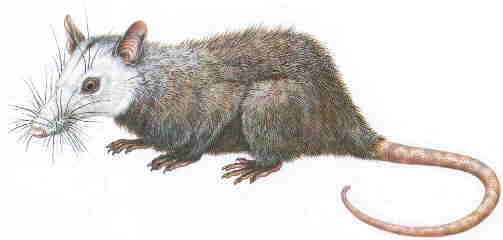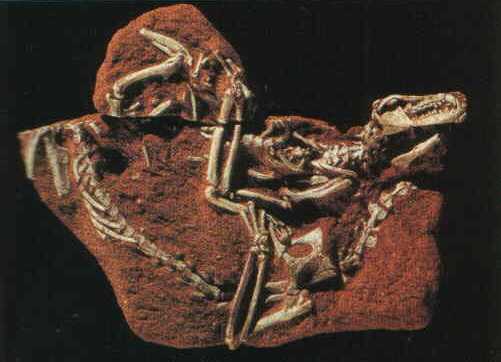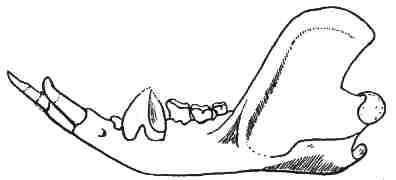
Marsupials are often associated with the Australian continent where such popular animals as kangaroos and koalas live. Less widely known is that a number of marsupials occur in South America today. These include the opossums, the only marsupials that also occur in the northern hemisphere today.
Surprisingly, Mesozoic marsupials are mainly known from North America, and they may have originated there during the Cretaceous. Primitive opossum-like marsupials are among the most common and most diverse mammals in the late Cretaceous of North America. They include cat-sized forms like Didelphodon, one of the largest Mesozoic mammals - and one of the most widely known thanks to its appearance in "Walking with Dinosaurs". Didelphodon had teeth specialized for crushing, and it has been suggested that it fed on hard shelled food like clams, snails, turtles or even young ankylosaurs.
The diversity of North American marsupials was dramatically reduced at the end of the Cretaceous. Only one single lineage, represented by late Cretaceous Alphadon and Paleocene Peradectes, survived the faunal turnover. Thus marsupials fared hardly better than dinosaurs in North America, and worse than reptiles on the whole. Peradectes survived into the Eocene, and a few other opossum-like marsupials appear in North America during the Paleocene. However, marsupials never became a significant component of northern faunas again and finally became extinct there. Opossums reentered North America from South America only a short time ago, after the Isthmus of Panama had formed in the Pliocene.

Figure 1: Reconstruction of Late Cretaceous Alphadon, based mainly on the appearance of todays opossums since only the dentition of this animal is known. This reconstruction should be equally valid for Peradectes, the Paleocene to Eocene successor of Alphadon. From Cox (1988).
Marsupials were much more succesful on the southern continents. They arrived in South America relatively late in the Cretaceous, but by early Paleocene time this group of mammals was flourishing there. Marsupials make up more than 50% of the mammal species in some South American Paleocene faunas, and adaptive types include insectivores, omnivores, carnivores and small herbivores. Paleocene mammals are not yet known from Antarctica and Australia. However, these continents were connected to each other and to South America at that time, and Eocene marsupials occur there. So it is highly probable that marsupials lived there during the Paleocene as well.
Many Paleocene marsupials of South America are closely related to todays opossums, which are appropriately called "living fossils". Opossums and their relatives belong to the order Didelphimorphia (named after the recent Virginia opossum Didelphis). Pucadelphys, a primitive opossum from the early Paleocene of Bolivia, is known from the best fossils for any early marsupial. Nearly complete skeletons have been found in pairs, which are interpreted as male and female. They were probably trapped in their burrows during a flood. Pucadelphys was an agile animal with some capabilities for bounding and digging, but without strong adaptations for climbing in trees. Like most recent opossums it was probably an omnivore that fed on insects, fruits and small vertebrates.

Figure 2: Pair of skeletons of the opossum Pucadelphys andinus from the early Paleocene of Bolivia, preserved in a life-like way just as resting in their nest. Skeleton on top of the figure faces to the right, skeleton at the bottom (without skull) to the left. From Rich & Rich (1993).
Abundant fossil Didelphimorphia are known from middle Paleocene fissure fillings in Brazil. Members of this order cover a large range of size and adaptation at that time. Minusculodelphis was close in size to the smallest known mammals. It is based on fossil jaws that contain teeth less than a millimeter in size! This tiny animal probably hunted for insects. Eobrasilia was much larger and had bulbous teeth similar to Late Cretaceous Didelphodon. It was previously considered as a relative of the carnivorous Sparassodonta discussed below, but is now regarded as an independent branch of opossum relatives that evolved towards a more carnivorous niche.
A second group of marsupials, the order Paucituberculata, is known in South America from the Paleocene to the present. During the Paleocene the most important members were the extinct polydolopids, rat to rabbit-sized animals that were somewhat similar to rodents in ecology. The middle Paleocene genus Epidolops is known from a nearly complete skull. All other polydolopids are only known from fossil jaws and teeth. Like rodents, polydolopids had enlarged front teeth. Still more distinctive was that some of their cheek teeth, especially the last premolars, formed large blades for cutting food. Similar blade-like cheek teeth have evolved independently in several groups of mammals, for instance the Mesozoic to early Tertiary multituberculates and todays rat-kangoroos. Such teeth could be useful for processing tough parts of plants, but an animal with this dentition could be an omnivore as well. Polydolopids declined in diversity during the Eocene and became extinct in the Oligocene, probably due to competition with other groups of Paucituberculata and with immigrating rodents and primates.

Figure 3: Lower jaw of the polydolopid Epidolops ameghinoi from the middle Paleocene of Brazil. Note the large front teeth and the blade-like last premolar. Later polydolopids like Polydolops developed strong serrations on this tooth. From Paula Couto (1952).
Finally, a group of marsupials started during the Paleocene to occupy the ecological role of carnivorous mammals in South America. These animals are classified in the extinct order Sparassodonta, which culminated in the dog- or bear-like borhyaenids and the sabre-toothed cat-like thylacosmilids of the later Cenozoic. Paleocene members of this order demonstrate the transition from primitive opossum-like animals such as Pucadelphys to ferocious predators. Mayulestes from the early Paleocene of Bolivia was a small predator which occupied a ecological niche close to that of weasels or martens. Adaptations like a prehensile tail show that this agile animal lived partially in trees. On the ground Mayulestes was probably capable of relatively fast but short runs to catch its prey.
The first larger sparassodonts are known from the middle Paleocene of Brazil. They include the medium sized genus Patene (meaning 'fox' in a native South American language) and a poorly known wolf-sized predator. These marsupial carnivores developed basically the same tooth structure for cutting meat as the true (placental) carnivores of the northern hemisphere. Unlike true carnivores, however, sparassodonts did not develop particular adaptations for fast running. This may have been one reason for their decline and finally their extinction after the arrival of true carnivores in South America in late Cenozoic time.
Sources of figures:
Cox, B. (editor) 1988: Illustrated Encyclopedia of Dinosaurs and Prehistoric Animals. Macmillan London Limited.
Paula Couto, C. de 1952: Fossil mammals from the beginning of the Cenozoic in Brazil. Marsupialia: Polydolopidae and Borhyaenidae. Amer. Mus. Novitates 1559, 1-27.
Rich, P. V. & Rich, T. H. 1993: Wildlife of Gondwana. Dinosaurs and other verterbates from the ancient supercontinent.